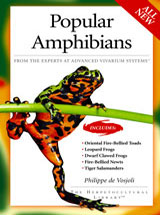To recognize illness in frogs, toads, newts, or salamanders, look for the following symptoms outlined in this article.
 |
Most pet frogs and salamanders, if initially healthy, tend to be hardy and relatively long-lived. If your amphibians have fared well for many months and suddenly look sick, first evaluate their living conditions. Often enough, wrong temperatures, high levels of ammonia or nitrites in water, fouled soil, and stress factors, such as excessive light or overcrowding, contribute to illness and a depressed immune system. Correcting these factors often causes frogs or salamanders showing signs of illness to become healthy again.
If your amphibians continue to look or behave sick, consider veterinary care. Unfortunately, veterinary treatment can be very expensive. A basic exam costs many times the cost of a single frog or newt. Add the costs of cultures and medications combined with the real possibility that sick frogs or salamanders might die despite medical attention, and you might decide veterinary care is not a viable option. In any case, the amphibians in your care deserve humane treatment and should not be left to suffer without intervention nor should they be killed by inhumane methods such as freezing.
To ensure the good health and long life of your amphibians, you must carefully design and maintain a terrarium so that the temperature, light, water quality, topography, furnishing, and diet meet the needs of your frogs and salamanders. Checking these conditions regularly will play a critical role in preventing the onset of disease in your amphibians. In addition, new animals must be quarantined prior to introducing them to a tank with established pets. Besides flaws in husbandry, the introduction of sick animals is probably the most significant cause of disease in established collections.
To recognize illness in frogs, toads, newts, or salamanders, look for the following signs:
1. Inactivity or unusual behaviors. The first thing you might notice in your amphibian is abnormal behavior or appearance. In fire-bellied toads, for example, inactivity and a horizontal posture (rather than the normal front-raised posture) are clear signs of illness. In salamanders, listlessness or struggling at the water surface indicate illness. With terrestrial amphibians, spending an inordinate amount of time in water is another sign of sickness.
2. Gradual or sudden weight loss. Signs of weight loss in frogs and salamanders appear in the abdominal area, which begins to look hollow, and eventually the outlines of the hip bones and backbones become apparent.
3. Body/abdominal bloat. This can be caused by excessive digestive gases associated with poor digestion caused by overeating, oversized prey, intestinal parasites, intestinal infection, respiratory infection, or gas bubble disease.
4. Skin blotches. The frog or salamander might display red blotches, caused by hemorrhaging, or white fuzzy blotches, caused by fungi.
5. Eye cloudiness. When a frog’s or salamander’s immune system is depressed, the integrity of the lens is often one of the first things affected by pathogens. Inappropriate water quality (such as too acidic or too hard) and high levels of toxins in the water will also affect the lens. Cloudy eyes are usually secondary to other problems. In rare cases, trauma to the head and orbit can lead directly to an infection in the eye.
6. Edema. This is a general swelling of the frog’s or salamander’s body, head, or limbs. Various factors, from poor water quality to bacterial infections and kidney disease, can cause edema.
1. parasites: “Amphibian Diseases: Parasites”
2. bacterial infections: “Amphibian Diseases: Bacterial Infections”
Excerpt from Popular Amphibians, part of the Advanced Vivarium series with permission from its publisher, BowTie Press, a division of BowTie Inc. Purchase Popular Amphibians here.

